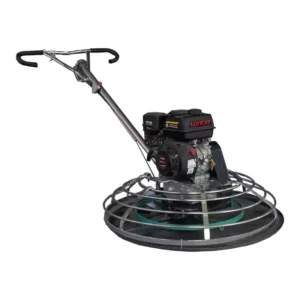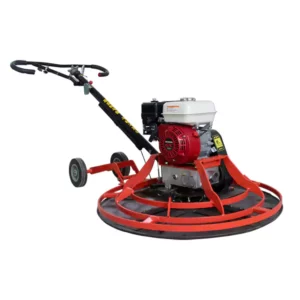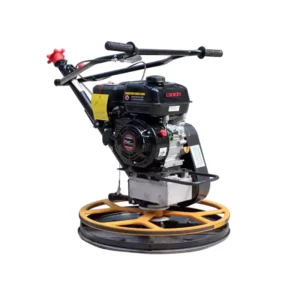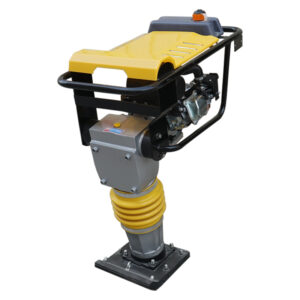For 50 years power floats and trowels have been used for finishing large areas of concrete flat- work. Using a 36-inch machine, a cement finisher can finish 700 to 1500 square feet per day depending on job and weather conditions. (In contrast, a cement finisher—with a good back—and hand tools can finish 300 to 600 square feet per day.) In order to achieve the highest production rates and gr eat – est profits , the power float must be used efficiently. Efficiency comes only with knowing the power float and its proper uses.Henan Xinsda Machinery Technology Co.,Ltd have more than 20 years of production experience. Dedicated research team and external sales team.Product quality is in a leading position in the construction machinery industry. Let our professional engineer team tell us what is Power floating.
The power float
The size of a power float is expressed by the diameter, in inches , of a circular area outlined by the moving blades. Machines vary from a 20-inch hand held model to an 96- inch riding model. The most common machine size is a walk-behind model, 36- to 48-inch-diameter, which costs from $1500 to $2000. While there are many different machine types, the basic parts and their function remain the same.

The blades of power float finish the concrete as they are swirled around the surface. Blades are classified as float (10 inches wide), trowel (6 inches wide) or combi- nation according to their basic use. Float blades are wider than trowel blades, with the leading edges turned up so they will not penetrate or tear the fresh concrete surface . The smaller trowel blades apply more pressure to densify the surface as the concrete hardens .
Combination blades, 8 inches wide, are used for both floating and troweling operations . A single blade will cost $8 to $14.
The blades are attached to a vertical rotating shaft by a spider assembly. Commonly three but sometimes four blades , equally spaced in a radial pattern, are attached to the spider assembly. A strong, rigid spider assembly is required to maintain vertical and horizontal control of the blades during the finishing operations .
An important safety feature is the guard ring, which allows the operator to move the power float close to walls and other obstructions without the danger of blade damage or breakage . The guard ring is connected to the engine housing.Engines for troweling and floating power floats are usually gasoline-powered and range in size from 3- to 11- horsepower. Electric motors are available if noise or carbon dioxide is objectionable. The engine drives through a clutch to a vertical shaft rotating the spider assembly and blades in a clockwise motion. Newly developed hydraulic machines are available which eliminate the need for gears and brakes.The handle, which is solidly connected to the engine, contains the clutch and speed controls and pitch adjustment. Without a safety clutch the blades would stop the instant the operator let goof the handle but the handle would spin and create a safety hazard. The rotating action of the blades can be adjusted to match the condition of the concrete surface by using the speed control. Blades are always flat during floating, but are tilted during troweling by using the conveniently located pitch adjustment control. Tilting the blades increases the finishing pressure on the concrete surface.

General principles of floating and troweling. Floating embeds coarse aggregate , removes humps and valleys and compacts the concrete surface. The concrete surface must be sufficiently hard and free of bleed water before power floating begins. The concrete should be a bit harder before power floating than it has to be for hand floating—it should take only a l/8-inch footprint indentation.
Troweling is done after floating to produce a dense, smooth, hard surface. Two or more successive troweling operations may be necessary to produce the desired floor surface. Allow time between successive trowelings to permit the concrete to increase its set.
To use the same power float for both floating and troweling requires the use of combination blades or clip-on float blades. Some contractors find it more productive to purchase two machines, one equipped with float blades and the other with trowel blades. This allows floating and subsequent troweling operations to proceed with- out delay. The extra power float can also be used as a spare in case of a breakdown.

For both floating and troweling operations the angle of the blade is important (Figure 2). For floating, the blade must be absolutely. flat to pr event tearing or gouging of the surface. During the first troweling pass, an old blade may be used flat because of its slight curvature due to wear. If a new blade is used on the first troweling pass, it should be slightly tilted. On each successive troweling pass the angle of the trowel blade is slightly increased to exert greater pressure on the concrete surface.
When a trowel blade is tilted or pitched at too great an angle , an objectionable “ washboard” or “chatter ” surface will result. If this occurs, reduce the tilt and continue troweling until the surface is smooth and level, after which the tilt may again be slightly increased. The tilt is excessive if the leading edge of the blade is more than 1 inch above the concrete surface.


